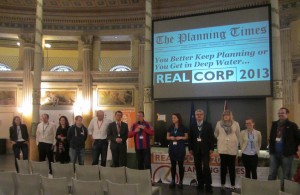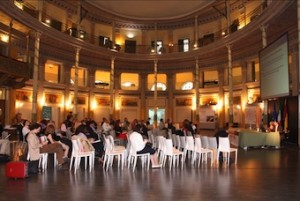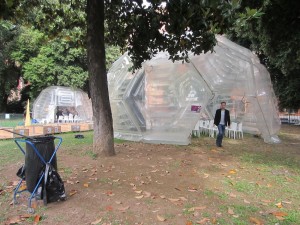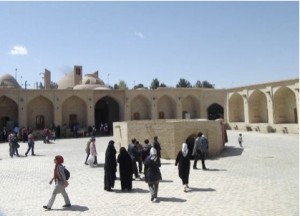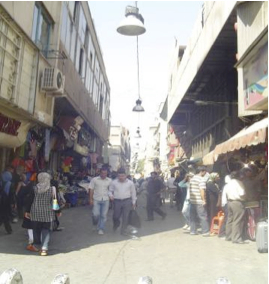OC 59: “Planning Times”
this post is about the CORP conference 2013. It took place in Rome, in alternance with conferences in Vienna and its surroundings from CORP had been initiated in the 1990s.
About CORP
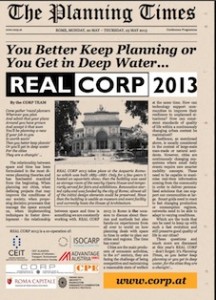
1_dia Front page of “The Planning Times” programme and background of REAL_CORP13. Source: www.corp.at
CORP (Competence Center of Urban and Regional Planning http://www.corp.at/index.php?id=18) has both staying power and innovative drive. Started at the Technical University of Vienna in 1996 as a networking initiative, harnessing information technology and focusing on how to apply ICT to urban planning and regional development in the information society, CORP has evolved continually and plans to do so in future, driven by Manfred Schrenk, his team and his professional network.
Over more recent times, CORP has moved from cold winters in Vienna to warmer times and climes, turning a European gathering into a truly international event, and branching out from techno-topics to policy and real time development issues, from academic analysis of cities to interaction with the whole team of protagonists involved in the production, change, maintenance and use of the built environment. CORP is also hosting workshops of its partners, among them Isocarp (International Society of City and Regional Planners, www.isocarp.org).
Some 250 participants presented their work, exchanged their experiences, enriched their professional networks and interacted with keynote speakers. One of many specificities of CORP is that it is publishing all the papers in advance and making them available freely on its website www.corp.at. This it does in the true spirit of advancement of scientific knowledge, something that tends to be under pressure with the commercialisation of universities.
This year, CORP took place in the house of architecture in Rome, a former aquarium from the 19th century and now the seat of the Roman architects, planners, landscape designers and heritage association. The broad range of aspects and participants required a range of spaces for discussions in parallel. Towards that end CORP invited Thomas Herzog to set up his pneumatic structures in the gardens of the House of Architecture. They reminded my generation of the pneumatic structures which were erected during the occupation of the Milan Triennale in the sixties when the ephemerality of inflatable materials stimulated the mind of designers.
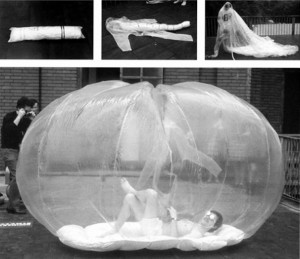
4_dia David Greene’s (Archigram) inflatable at the 1967 Triennale in Milan, source:
http://architecturewithoutarchitecture.blogspot.co.uk/2012_12_01_archive.html
These ‘gismoz’ were a live application of bringing together time – or temporality – with space. They also reminded planners of the imponderables of nature. Rome in May this year had little to do with expectations. Short sharp apparitions of the sun threatened to turn the gizmos into green houses and thunderstorms had the better of them. Nevertheless, they contributed to reflections on periodicity, on ideas being born, discarded and rediscovered at other times in other spaces for different uses.
Time in spatial disciplines
It may surprise that CORP had singled out time as focus of its deliberations this year. Cities are changing all the time, but plans are traditionally a-temporal. They may well fix a vision for a future time, but it is static, often two dimensional, accompanied by abstract and normative writing, addressed to nobody in particular. In a period when time is lived in seconds, even nano-seconds, how is it possible to fix anything of any significance in space statically? Conversely, how is it possible to prepare any bases for decision making without representing moments in time, fixed at least for a while, before being activated politically, notwithstanding that both calendar time and urban time never stop moving?

6_dia time – space planning in education, source
http://timespaceeducation.wordpress.com/category/planning-2/
How is it possible to plan in times of constant change in cyberspace, no matter what: values of shares and stocks, political landmarks, natural or man-made disasters? Is it sensible to plan space in times of instant gratification when lived moments are seamlessly transmitted into cyberspace, acted upon and responded to? These questions constituted the context of CORP13.
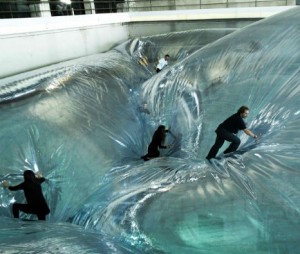
7_dia space-time urbanism, source: http://weburbanist.com/2012/12/11/on-space-time-foam-surreal-billowing-art-installation/
While maintaining a techno-strand on data, information infrastructure and new technologies of representation and simulation for planning, CORP wanted to relate real space to real time, as well as to real life. This has been the query of natural sciences for times immemorial without ever producing definite answers. It may be quite daring for a much more hybrid field like planning to take on this paradigmatic scientific proposition. Not a reason for CORP not to try.
The conference opted for five strands: passing of time in physical historic space; pace of flows especially in the urban economy; experience of time by diverse parts of society in cities; how to include time in planning methodologies: real time, imagined time, time transformed by memory; and time which never seems to catch up with underdevelopment. All in all a tall order. Impossible even to attempt any convergence of ideas, scientific approaches, or positions.

8_dia memory and imagination, the female and male brain hemispheres, source:
http://michelemiller.blogs.com/marketing_to_women/2005/12/your_brain_on_s.html
Two diverse perspectives of time-space in planning
The CORP website, the papers and keynote addresses are giving a comprehensive account of the ‘state of the art’ deliberated in Rome. Just two diverse aspects are singled out here of how the time-space relation in planning has been interpreted from different social and professional cultures. One set of views was arranged around memory and imagination, and in particular how human perception and dominant planning ideas (ideologies?) are changing over time. The other moved around methodological aspects of planning, how they are changing over time and how to include time in spatial planning under unpredictable and uncontrollable circumstances.
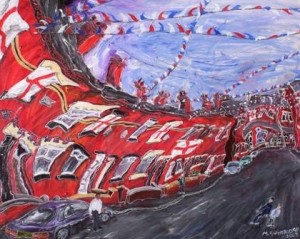
9_dia urban memory and imagination, Queen’s silver jubilee 2002 and migration, Manchester, source:
http://bezalel.secured.co.il/7/Crawshaw_%20Fowler_For_ever_and_ever.htm
One session brought together two views of creating collective memories and identity of place from the Middle Eastern standpoint. Both authors took the long view. However, Mohammed Qasim, was resorting to fundamental western scientific ‘truths’ and architectural icons, while Nasim Iranmanesh, was starting from the cultural values of the Islamic world and comparing them with western spaces and their suitability for human interaction in different cultures.
Their perception of how spatial memory and identity is generated contrasted with the spaces studied by Jurgen Lafrenz, who illustrated the cyclical influences of contradictory planning theories on the urban fabric over centuries, while the observations of Anastasia Kuznetsova and Yulia Bushmakova of Perm focused on the saccadic one-off change that Perm’s fabric is undergoing since the fall of communism and how to integrate the fabric from the period of industrialisation harmoniously into the historic areas that have survived over longer periods.
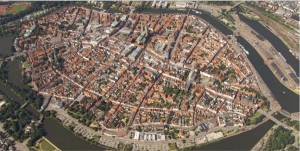
11_dia Lubeck, still essentially in its medieval form, but changed back and forth at a more differentiated scale, source: Jurgen Lafrenz CORP13 paper

12_dia Historic facades contrasting with those dating from industrialisation in Perm, Russia, source: Anastasia Kuznetsova et al CORP13 paper
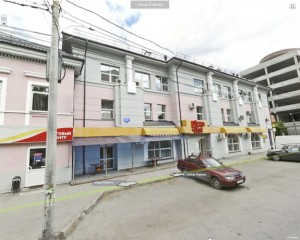
12a_dia Historic facades contrasting with those dating from industrialisation in Perm, Russia, source: Anastasia Kuznetsova et al CORP13 paper
The other session addressed contradictions and conflicts in urban change encountered during a one-off socio-political change and how it was lived in Belgrade and Bucharest respectively. Both studies refer to communist and post communist periods, but the time immediately after the demise has been lived very differently in the two cities. Aleksandra Stupar and Mira Milakovic showed that in Belgrade, during the hiatus people colonised the public spaces of modernist New Belgrade with informal buildings and activities, while Diana Andreea Onose and her team noted a complete stand still between the fall of Caucescu’s regime and the integration of Romania into the European Union and its efforts to comply with its principles of regional and urban development expressed in ESDP (European Spatial Development Perspective).
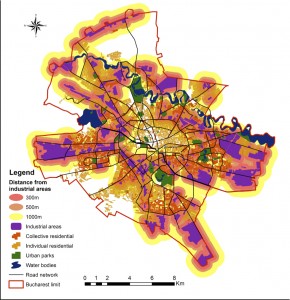
14_dia Bucharest, influence of industrial areas on redevelopment, source: Andreea Onose et.al., CORP13 paper
These observations from practice and their implication for planning contrasted with Italy’s complexity in incorporating time formally into its long term planning process presented by Marco Mareggi, and the unplanned spontaneous way studied by Xi Guangliang and Zhen Feng of how the Chinese government is resorting to micro-blogging despite censorship of virtual communication, in times of natural crises where instant information is crucial for rescue operations.
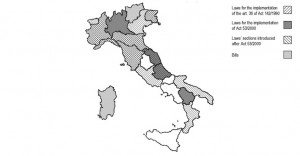
15_dia Map of Italian regions and diverse legislation to incorporate time in spatial planning, source: Marco Mareggi, CORP13 paper
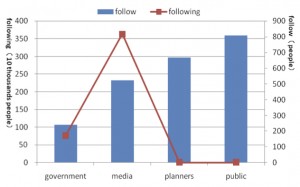
16_dia Analysis of use of micro-blogging during rainstorm disaster in July 2012 in Beijing, China, source: Xi Guangliang et. al., CORP13 paper
These two groups of studies about time in spatial planning illustrate the broad range of aspects that were brought to the CORP conference about the time-space relation in planning and urban development, differentiating between a panoply of times and how to relate them to space at different scales. What enriched the academic approaches to the time space relations in planning and urban development was the standpoint of the development industry, not least of those who trade in real estate for whom time means money rather than space which is perceived essentially as money generating location. The merit of their time lies in the acceleration and accumulation of property transactions whereby speed is of the essence, quite contrary to longer term time periods of interest to those who care for urban heritage or the ‘slow’ movement (see Cecilia Scoppetta, New geographies of self-organisation, CORP13) which is subjecting urban space to urban activities and their evolution according to organic time.
source:
http://www.losquaderno.professionaldreamers.net/wp-content/uploads/2012/11/losquaderno26.pdf

